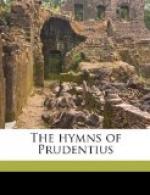with
St. Luke’s word for “manger” (phatne). After referring to the
circumstances of the Nativity, Origen proceeds to say: “That was
what the prophet foretold, saying, ‘The ox knoweth,’ etc. The Ox is
a clean animal: the Ass an unclean one. The Ass knew his master’s
crib (praesepe domini sui): not the people of Israel, but the
unclean animal out of pagan nations knew its master’s crib. ’But
Israel hath not known me: and my people hath not understood.’ Let us
understand this and press forward to the crib, recognise the Master
and be made worthy of his knowledge.” The thought that the Ox = the
Jews and the Ass = Pagans, reappears in Gregory Nazianzen, Ambrose
and Jerome. See an interesting article by Mr. Austin West (Ox and
Ass Legend of the Nativity. Cont. Review, Dec. 1903), who notes
the further impetus given to the legend by the Latin rendering of
Habb. iii. 2 (LXX.) which in the Vetus Itala version appears as
“in medio duorum animalium in notesceris,” “in the midst of two
animals shalt thou be known” (R.V., in the midst of the years make
it known). The legend does not appear in apocryphal Christian
literature earlier than in the Pseudo-Matthew Gospel, which
belongs to the later fifth century. It is interesting to note that
with St. Francis and the Franciscans the ox and the ass are merely
animals: the allegorical interpretation of Origen had vanished from
Christendom: and in its place we find St. Francis (see Life of St.
Francis by St. Bonaventura, “Temple Classics” edition, p. 111)
making a presepio at Greccio, to which a living ox and ass are
brought, in order that a visible representation of the manger-scene
might kindle the devotion of the Brethren and the assembled
townsfolk. This act of St. Francis inaugurated the custom, still
observed in the Roman Church, of representing by means of waxen
images the whole of the Nativity manger-scene, Mother and Child
together with the adoring animals.
St. Luke’s word for “manger” (phatne). After referring to the
circumstances of the Nativity, Origen proceeds to say: “That was
what the prophet foretold, saying, ‘The ox knoweth,’ etc. The Ox is
a clean animal: the Ass an unclean one. The Ass knew his master’s
crib (praesepe domini sui): not the people of Israel, but the
unclean animal out of pagan nations knew its master’s crib. ’But
Israel hath not known me: and my people hath not understood.’ Let us
understand this and press forward to the crib, recognise the Master
and be made worthy of his knowledge.” The thought that the Ox = the
Jews and the Ass = Pagans, reappears in Gregory Nazianzen, Ambrose
and Jerome. See an interesting article by Mr. Austin West (Ox and
Ass Legend of the Nativity. Cont. Review, Dec. 1903), who notes
the further impetus given to the legend by the Latin rendering of
Habb. iii. 2 (LXX.) which in the Vetus Itala version appears as
“in medio duorum animalium in notesceris,” “in the midst of two
animals shalt thou be known” (R.V., in the midst of the years make
it known). The legend does not appear in apocryphal Christian
literature earlier than in the Pseudo-Matthew Gospel, which
belongs to the later fifth century. It is interesting to note that
with St. Francis and the Franciscans the ox and the ass are merely
animals: the allegorical interpretation of Origen had vanished from
Christendom: and in its place we find St. Francis (see Life of St.
Francis by St. Bonaventura, “Temple Classics” edition, p. 111)
making a presepio at Greccio, to which a living ox and ass are
brought, in order that a visible representation of the manger-scene
might kindle the devotion of the Brethren and the assembled
townsfolk. This act of St. Francis inaugurated the custom, still
observed in the Roman Church, of representing by means of waxen
images the whole of the Nativity manger-scene, Mother and Child
together with the adoring animals.
97 For the obstetrix, cf. Proto-Evangelium
of the Pseudo-James (a
Greek romance of the
fourth century), Sec. 18 et seq., where Joseph
is represented as seeking
and finding a Hebrew midwife.
100 Cf. Milton’s Ode on the Nativity, ll. 157-164:—
“With such a horrid
clang
As on Mount Sinai rang
While the red fire and smould’ring
clouds outbrake:
The aged earth aghast
With terror of that blast,
Shall from the surface to the centre shake;
When at the world’s last session
The dreadful Judge in middle air shall spread
his throne.”
XII




